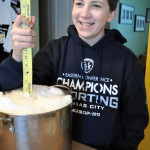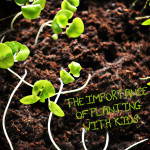It’s amazing how much a simple change can make a huge difference in the end result. It’s especially true when it comes to climate and how things grow in different conditions (and why a shift in the weather for a given month can drastically change how plants grow).
Have you ever been to the store and found a shortage or a price increase on favorite produce, or even any other product? Well, part of it may not be stinginess on the part of the store, or increasing costs for the farmer. It actually may be directly related to how much product was able to be grown due to rainfall, temperature, and other climate conditions. Things like this winter’s Polar Vortex, or the fact that we’ve had record cold temperatures for the month of March so far here in Kansas, can impact seasonal planting, which in turn may limit the amount of crops produced. When there’s a shortage, prices skyrocket!
You can teach your kids about this concept with this easy experiment that costs less than $1.50 to complete. I’m even including a free chart printable, so stick around for the free download!

Aside from the chart printable, you’ll need some bean seeds, three damp paper towels, three small Ziploc bags, and some tape.

Start by putting a damp paper towel in each of the three bags, and then layer 4 bean seeds on top of the paper towel. The reason you want more than one seed is that, in case one is simply not going to sprout, you have some extras. Not all of them will grow the same in the same conditions due to variances in the beans, so you’ll want more in order to see the general trend, even if you have a “dud bean.”

Seal the bags, and you’ll get a mini greenhouse, basically!
From there, you’ll put your bean seeds in three different places:
-A dark, cold space– we chose a mini fridge that doesn’t have a light, so even if it were opened, in the back of the fridge, very little light would reach the bean during the experiment.
-A dark, warm space– we chose the underbed storage in Jeffrey’s bedroom, which is located somewhat near the heat register, allowing it to be completely closed off from light, but easily accessible when it comes to warm air flow.
-A light, warm space– we chose to tape ours inside a window that gets a lot of light. While the window is above a heat register, we did do this experiment in the winter, and since the other warmer parts of the room don’t get quite enough light, our seed may have had a different-than-usual result due to being cold on one side. We’ll talk about that later.
Take a few minutes to write a hypothesis about what seeds will experience the most growth, and which will experience the least growth. Consider where we typically plant seeds. Do we plant them where they’ll get sunlight, or where they’ll stay in the dark? Do we plant them when they’ll have warmth, or when they’ll be cold?
Leave the beans undisturbed, aside from your daily charting. Each day, you’ll want to go in and take a note of the beans’ growth, if any, and consider how the growth you’re seeing might line up with the hypothesis you made at the beginning of the experiment. Also be sure to take some pictures of the growth!
For older students, checking the beans every day is a great way to make sure you’re getting the most accurate information regarding the seed growth. However, since growth can be slow during the duration of the experiment, for younger students, it’s okay to check every few days.
Let this go for 2 weeks (allowing you 10 school days to check on the experiment), and on the 10th school day, gather the bags (making sure you keep track of which is which!)

We noticed that, after our experiment, the cold, dark seed experienced absolutely no growth. Not even a little! The cold, dark climate of the refrigerator just wasn’t enough to sustain life for the bean, so it had no result.

Our dark, warm seed experienced the most growth! However, if you look at the color, it doesn’t look very green, like a green bean, does it? It’s got a sickly white color to it.

Finally, the warm, bright plant was checked, and even though it didn’t grow as long as the plant in the dark, it did experience a beautiful green color, showing that it was able to get nutrients from sunlight to become a healthy plant.
One thing to note is that, had our warm, bright plant been kept in a warmer spot farther away from the cold window (or if we had done the experiment when it was warmer outside), the warm, bright plant may have grown longer than the plant kept in a dark, warm room. However, the cold of the window likely stunted the growth slightly.
You’ll also want to be sure you’re measuring your plant using centimeters, not inches. For one, the scientific community uses metric measure as a standard unit for length. Also, can you imagine having your child wait for their plant to reach an inch? Centimeters will be able to be charted earlier, keeping kids interested in the experiment and excited to check their plant to see growth that seems more rapid than growth measured in a longer unit like inches.
Finish the experiment by drawing a conclusion. Why do you think the dark, cold plant didn’t experience growth? Why did the other plants experience so much more? What is the color difference like between the two warm plants, and what do you think this means for the two plants? Was the experiment result close to what you hypothesized when you started the experiment?
To make charting your daily growth easier, I designed this fun chart!

You can download the full-sized 8.5×11 version here. Be sure to encourage your child or student to label the X-Axis and Y-Axis properly. For those unfamiliar, the X-Axis runs horizontally, and for the purpose of this experiment, represents the days of the experiment, with a box for each school day during the experiment. The Y-Axis runs vertically, and in this case, represents length in centimeters.
Enjoy charting, and please come back and share your results here if you try the experiment! I’d love to hear about your experience and results!





sounds like a good way to learn about plants and weather. Thanks for sharing.